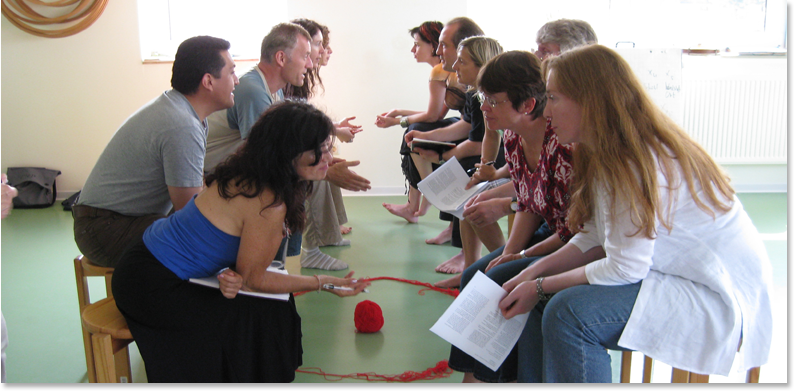Psychodramaturgy for Language Acquisition
[In French: Psychodramaturgie Linguistique (PDL)]
Notes
To simplify things, the trainer will be referred to as “she” and the participant as “he”.
We recommend reading the course progression first, to facilitate the understanding of the basic principles: Course progression
How can we make acquisition of foreign languages easier?
Dr. Bernard Dufeu, University of Mainz, has been developing and working on Psychodramaturgy for Language Acquisition in collaboration with Marie Dufeu, Centre de Psychodramaturgie Mainz, since 1977.
The theoretical and practical foundations are constantly being deepened and expanded.
Psychodramaturgy owes its name to Psychodrama and Dramaturgy from which it has borrowed insights and methods which, adjusted to fit the foreign language classroom, enhance language acquisition.
Despite the name, however, a PDL class is neither theatre nor Psychodrama.
PDL has drawn on many sources (see Sources), and Bernard and Marie Dufeu and other trainers are continuously developing and adding new exercises.
Together with the theoretical and methodological framework of Psychodramaturgy, these new sources and exercises make up a coherent and unified whole.
Target Groups
The scope and area of application of Psychodramaturgy has expanded considerably over the past ten years. It was first designed for adults, but is now also being used with children and adolescents, in both extensive and intensive courses. The PDL method was first used primarily in small groups. Today, its techniques and methods are being employed successfully in groups as well as in one-to-one classes.
Field of Application
The Psychodramaturgy (PDL) was not developed as an isolated theory. It can also contribute to improving language classes in general. In view of this, there are two possibilities for application.
- in the basic version, PDL can be used as an integral and complete method. Intensive courses (3 to 6 hours per day) over one or more weeks or at weekends are recommended. The ideal group size is 8 to 12 participants, although some trainers do work with larger groups. PDL courses can be conducted with a single trainer or in a team of two.
- a selective application of PDL exercises and methods in other types of language teaching, especially in extensive courses or with larger groups. It is also possible to apply PDL techniques to textbook teaching. Language trainers may thus enrich their pedagogical practice with methods that appeal directly to the participants and allow for language training that is both lively and effective.
An approach for all levels
The Psychodramaturgy is a method that allows trainers to facilitate students’ progress in a foreign language at every level: from the initial steps to higher levels of proficiency. The theoretical foundations of PDL and its practical application form a coherent whole which enables the trainer to work precisely and effectively. The spectrum of exercises and techniques encompassed by PDL can be used flexibly and can be adjusted to the individual level of the student within the group.
The Psychodramaturgy offers an approach that progressively and flexibly introduces beginners to the foreign language and leads them to an advanced level.
- After an intensive course of usually four or six weeks, beginners have generally acquired communication strategies and an ability to express themselves which allow them to deal with everyday situations in the target language.
Two approaches may be taken for advanced students:
- a general approach for participants who wish to refresh, improve and deepen their general skills such as communicating better or reading press and literature in the target language.
- a specific approach for participants who wish to master particular business situations and language functions used at work. Participants with a good basic knowledge of the target language learn to communicate effectively in these situations after about 60 hours (four weekends or two intensive weeks).
Everyone learns from everyone else
The Psychodramaturgy allows for a wider heterogeneity in the makeup of a group than traditional classes allow.
The keystone of Linguistic Psychodramaturgy: A Pedagogy of Being
“I belong to that opposition party;
the one we call Life”
Honoré Balzac
The Psychodramaturgy is part of a Pedagogy of Being; i.e. a pedagogy that is participant and group oriented and therefore subject-related and process-directed. It constitutes a Pedagogy of the Way.
Its methods and approach to participants differ fundamentally from those of a "Pedagogy of Having" that is based on transmission of content and achievement of goals established in absentia of the group. Standard textbook use not only leads to an estranged assignation of the linguistic content, but also strongly determines the progress, communication and relationship of the class.
Having is subordinated to Being.
The following table shows the schema of the conceptual differences between the pedagogy of having (conventional teaching) based on transmission of more or less abstract knowledge, and the pedagogy of being, based on experiencing directly and living the language:
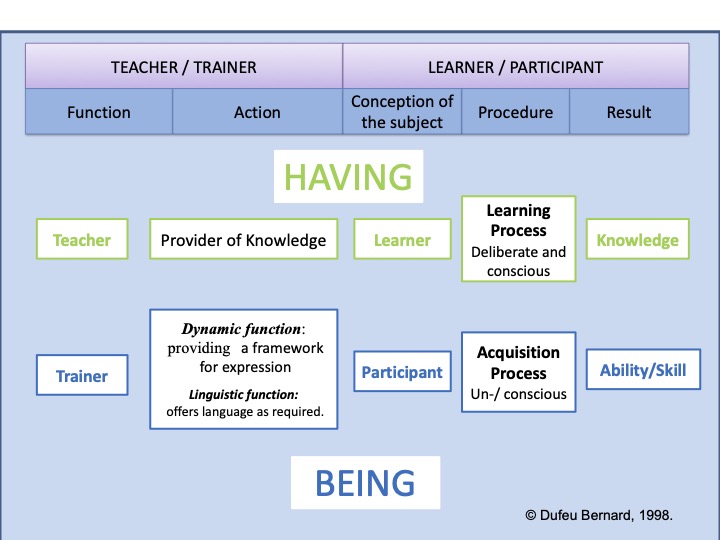
In PDL, "Having" is subordinated to "Being" and abstract, intellectual, cognitive knowledge (declarative knowledge) is subordinated to the practical, hands-on, experienced knowledge (procedural knowledge).
The direct experience of the language has priority. It is supported and enhanced by theoretical knowledge about the language.
A Pedagogy that views living and learning as one
One wants to prepare them for a future life, but they already ARE.
Life and Learning are not separated by artificial didacticism; they constitute a whole. Every pedagogical act is an act of life.
The pedagogy not only practises the mastery of future situations, it is also a part of the participant’s and the group’s life in the present. It not only prepares for possible situations in the future, it is itself life, life which expresses itself directly or symbolically on a real or imaginary level. Learning is a process of life and life is a continuous process of learning.
A pedagogy that considers the two dimensions of acquisition and learning processes
Every act of acquisition plays a role in the participant’s life and contributes positively or negatively to the overall development of the participant. PDL encourages not only acquisition of language, but also of the mindsets, attitudes, capabilities and skills that enable and facilitate foreign language acquisition and simultaneously contribute to the development of the individual as a whole.
The act of learning cannot be detached from the subject.
Acquiring a foreign language contributes to the individuation process in which the individual, in constant development, is a being in the making. The acquisition and learning process, through the exercises, allows the individual to be himself in the target language; or even to transcend himself and be different or explore and expand his possibilities of being. He develops his spontaneity and creativity as well as the two fundamental abilities that are indispensable when we acquire a foreign language: receptiveness and expressiveness. The development of these capabilities not only enhances language acquisition, but also plays a major and active role in the learning process.
We have summarized this duality of language learning in the following table:
Concept of Language Acquisition in Psychodramaturgy
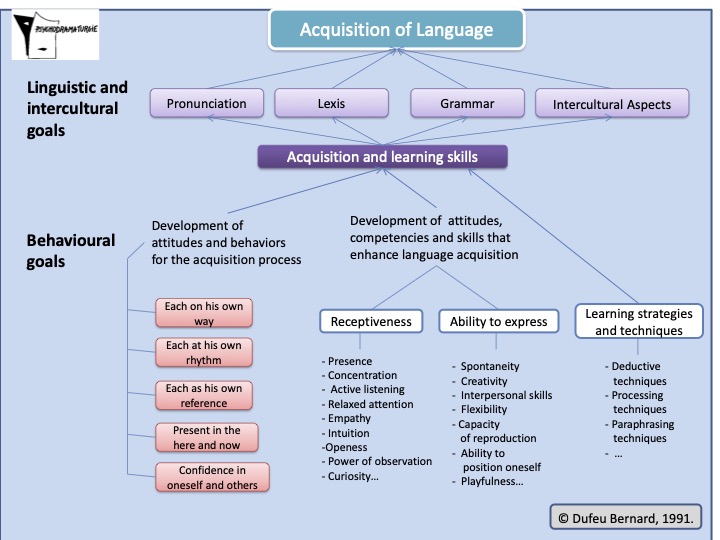
Textbook oriented teaching concentrates predominantly on linguistic and inter-cultural objectives (surface aims - see upper part of the table), particularly on the transmission of structures and vocabulary and/or (inter-) cultural content.
To achieve these goals, PDL focuses on the deeper levels. It emphasizes and enhances in particular the development of attitudes, capabilities and skills (deep aims - see lower section of the table) that encourage language acquisition and so PDL includes the development of the individual as a whole in its concept.
The development of these abilities happens through exercises which encourage the participants’ expression and inter-group communication, and also facilitates the acquisition of the language. The participants reach their linguistic goals all the better as the language is being put to use by those who need it at the very moment the need arises. The Having (here the linguistic and inter-cultural goals) is better integrated as it resonates with the Being.
A psychodramatic pedagogy
The founder of Psychodrama, J.L. Moreno, developed the role-play in the 1930s. His influence on pedagogy is therefore not new, however, the implementation of the role-play in traditional teaching has very often led to an impoverishment of the Moreno role-play.
PDL is based on some of the theoretical foundations of psychodrama: the encounter, the action, the play and the creative spontaneity.
- The encounter is one of the basic themes of J.L. Moreno. One of his first works is entitled “Einladung zu einer Begegnung” ( (J. L. Moreno: Einladung zu einer Begegnung. . [Invitation to an Encounter], Wien: Anzengruber Verlag, 1914).
In Psychodramaturgy, the encounter is enabled by activities that place language as the medium for the direct encounter between participants (and not, as in conventional teaching, as an abstract syllabus or a goal of the teaching process). That is why we call PDL a pedagogy of encounter. - The Concept of Play is coupled with the Concept of Action. Due to the incorporation of the imaginary, the Play possesses a protective as well as a stimulative function. It allows for a safe framework in which new ways, attitudes, and behaviour can be explored and accepted
- “Drama” in its etymological sense means “Action”. The participants acquire language through communication in action, interaction and relation; instead of talking about somebody or something unrelated to him (other people, facts, information about the language, etc. ), he speaks to somebody. Reflection arises from, accompanies and rests on action.
- The build-up of PDL exercises is based on Moreno’s concept of creative spontaneity (cf. Moreno J.L. (19532:Who shall survive? Beacon, Beacon House . In German:J.L. Moreno (1967): Die Grundlagen der Soziometrie. Köln, Westdeutscher Verlag:, 11-18, 437-444).
Warm-up exercises lay the ground for the main exercises, encourage spontaneity, activate creativity and stimulate the participant’s wish for expression.
In-between exercises between the main exercises offer an interesting alternative and also offer an opportunity to further develop the necessary abilities to acquire a foreign language. - The teaching style of the trainer is also influenced by the function of the trainer in Moreno’s Psychodrama. The trainer has a structural function, offers the parameters for the activities, and adapts them to fit the group. She plays an important role in accompanying the group by supporting the participant in his wish for expression.
She combines the verticality of the leader with the horizontality of the supporter. Instead of the hierarchy often found in conventional teaching, she fosters a relationship based on empathy.
A dramaturgical pedagogy
Some dramaturgical principles need to be considered when choosing situations, subjects, texts, and construction of exercises:
- The principle of dramaturgical forces: the meeting of antagonistic and supporting forces allow for dynamics.
- The resonance principle: the situations and topics address and appeal to the participants.
- The consideration of micro and macrocosmic relations: the relation between the world inside (here the situation in the group) and the world outside needs to be considered.
- The set up of some exercises (the choice of topics and texts) in the elementary, intermediate and advanced courses integrate principles from dramaturgy; e.g. the principle of dramaturgical forces that for example lend dynamics to a text, the principle of polarities (the encounter of conflicting forces), or the principle of resonance. All these make the group and the individual more dynamic.
- PDL sometimes draws on certain dramaturgical forms of expression (forum theater, freeze-frame, ...) that derive from actor training.
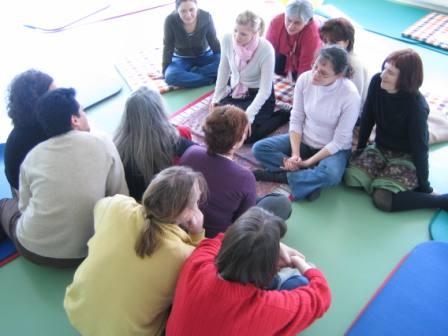
The subgroups in the doubling position supporting the protagonists
- The use of plain white masks in the first four days. Their use derives from actor training. In PDL, the masks have a protective function and promote the perception of the trainer’s and one’s own voice.
- PDL creates a „potential“ and “transitional” space (see. D. W. Winnicott (1971): Playing and Reality, London Tavistock Publications) that plays an important symbolical role for the participants as it offers them a place in which to merge their realities and fantasies and their different personalities, and to encounter themselves in a variety of roles.
A pedagogy of relation
Autonomy and Interdependence
The members of the group are seen as “participants” because they participate in their own acquisition and learning process and determine the themes and situations themselves and because they “take part” in the life of the group.
The concept of the learner is only used in the context of conventional teaching.
The teaching method allows the participants to relate to themselves, to the other participants, to the group as a whole and to their environment and world at large. It is not only about linguistic autonomy, but also about developing a sense of solidarity and joint responsibility, i.e. to be aware of the constructive interdependence of every individual within the group or, for that matter, society at large.
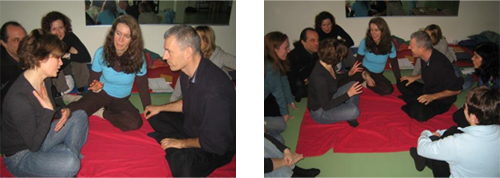
Encounter with group support
A Holistic Approach
PDL addresses the participant on various levels: physical, affective, intellectual, social, and spiritual:
- The Body is used directly in various speaking and language acquisition exercises, particular movements ease the perception and the production of characteristic pronunciation, poems are accompanied by gestures that accentuate various aspects of the foreign language. Some of the warm-up activities begin with a certain posture or movement before the verbal expression. As the class is usually held without desks or tables, the participants can determine their preferred distance from the other participants in the group themselves. They are free to choose where and next to whom to sit, and how close they wish to be. This gives the body more freedom of movement.
- The Affective Dimension: The participants express themselves as individuals with their own wishes, needs and hopes. This affectivity (their feelings and emotions) accompanies and stimulates their expressiveness automatically.
- The Intellect continuously accompanies, both consciously and unconsciously, the observation and the direct acquisition of the language. In the reflection phase, it is involved directly and consciously.
- The Social Dimension also plays a major role as many of the activities heighten the listening to and the perception of oneself, as well as of others. Empathy and solidarity are also cultivated. Other exercises promote group work and the mutual support of the group.
- The Spiritual Dimension: The symbolical meaning of some exercises and the inclusion of imaginary realities touch the participants’ and trainers’ Weltanschauung, their conception of man and of life, and their ways of communicating and relating to others.
These five dimensions or levels are inter- and co-dependent, and influence and build on each other.
Individual acquisition and learning in a group
The participants will progress better
if we respect each one’s individual rhythm.
PDL rests on a conception of Man as a unique being; a being that is in a constant process of dynamic development. If every person is unique, then teaching methods must be used in which each participant can go his own way and follow his own acquisition and learning rhythm.
This also means that language goals cannot be standardised.
Each is his own point of reference.
Acquisition and learning are individual processes. PDL takes this into account and adapts and adjusts its methods to fit the different levels and acquisition and learning rhythms of the participants, thus enabling individual progress.
PDL is also group-oriented. After the individual-oriented work in the first four days in which each participant is introduced to the language individually, PDL makes a relational progression. We go from the monologue to the dialogue; participants begin to take part more directly in the acquisition process.
The protagonists are supported by the trainers and increasingly by the other participants in the group: this means that PDL not only trains autonomy, but also solidarity and interdependence. Differences in language levels are used constructively.
The methodological foundations of PDL
One consequence of being participant and group-oriented is that no textbook with heteronomous (not determined by the self) content, syllabus and learning progression is used. In the introductory phase, language arises directly within and from the group. In the later stages, the group itself is taken into consideration in the set up of exercises and choice of topics and texts. The participants are addressed on the real and the imaginary levels without having their personal space intruded upon (the imaginary not only stimulates the imagination, but also offers protection).
Each participant is the architect of his own language.
The trainer offers the participant a framework for action and encounter that stimulates the wish for expression. The students determine directly the content of their statements from the second intensive course day onward (See Course Progression):
Specific exercises allow them to express themselves with increasing competence. Missing language and vocabulary is provided by the trainer and in the more advanced stages by other participants through appropriate techniques such as doubling. They learn the language directly in communication with each other. Direct contact to the language is established. This leads to a unity between the speaker and what is spoken, between what he wants to say and what he actually does, between what he understands and what he actually learns. This correlation between the speaker and his words eases the process of acquisition and heightens the participants’ motivation to learn.
This table illustrates the stages of the pedagogical process:
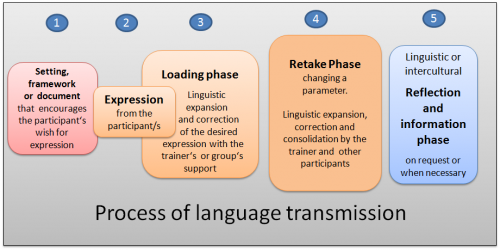
1- Starting off with a setting, an opening activity or a supportive text, picture, object, etc. that serves as a framework or a starter and stimulates the wish for expression, the participants then express themselves in the Expression Phase.
2- Self expression by one or several participants as well as they can and with the support of the trainer.
3- In the Charging Phase, the trainer offers language to strengthen, expand and possibly also correct the language of the original statements.
4- This is followed by the Retake Phase in which a parameter of the communication situation is changed. In this phase the language is again expanded and repeated and properly integrated. These techniques also stimulate the participant's imagination as they also possess warming up dynamism.
5- The Reflection Phase occurs when participants start asking questions about corrections or the trainer considers some explanation to be useful.
The unity between the speaker and his words
In conventional language classes, the student suffers a double alienation: The words are not theirs as it is not their native language (first alienation) and they are not one with their words, i.e. the words do not correspond to what they wish to say (second alienation). This double alienation impedes real communication between the participants, reduces their interest, their perceptiveness, their motivation and curbs their concentration and memory. It slows down the learning process.
The first thing is to establish a positive relationship with the language.
PDL reduces the first alienation by sensitizing the participant to the prosodic and phonetic characteristics of the foreign language from the very start. Pronunciation is one of the main factors that make a foreign language foreign.
Special techniques that facilitate the perception and reproduction of the characteristic sound of the foreign language reduce its foreignness and thus make learning easier. PDL tries to establish a positive relationship to the foreign language in order to make it more accessible and to reduce its foreignness.
When it’s their own words, it can become their own language.
PDL also reduces the second alienation by allowing the linguistic content to arise directly from and within the group. It arises out of the participants' wish for expression in the very situations the participants helped set up. The participants are directly involved in the choice of language and are therefore co-authors of the language introduced in the course.
They share the responsibility for the linguistic content and their acquisition process.
Creating an atmosphere of trust
Several components are used in PDL to create an atmosphere that is conducive to acquisition, that reduces inhibitions and barriers, and boosts confidence and motivation to express oneself in the foreign language.
Acknowledgement of the personal acquisition and learning rhythm:
PDL acknowledges that everyone makes his way at his own rhythm when introduced to and learning a foreign language. It also means there is no compulsion to learn.
Invitation to Making Mistakes
Making mistakes is viewed as an indispensable developmental phenomenon when learning a foreign language. It is the reason why we speak about “error” and not about fault. There is no connotation of blame or guilt. The attempt to reduce mistakes not only inhibits expression but also slows the learning process.
Relaxation and Breathing Exercises
Encourage receptiveness, boost concentration, and create an atmosphere of relaxed concentration.
These exercises also increase receptivity and expressiveness, at the same time encouraging contact between participants and fostering a comfortable and informal atmosphere in the group.
Exercises to increase receptivity and expressiveness
Encourage the interpersonal contact between the participants in the group and contribute to the development of a pleasant atmosphere in the group.
Techniques and exercises that combine precision and flexibility
Follow rather than lead
The progression when introducing a foreign language is at first based mainly on relational criteria. This is supported by exercises that are finely tuned to follow up on each other and build a coherent whole. Every main exercise is preceded by a preparatory warm-up exercise. In-between exercises vary between individual, pair and group work and strengthen the skills needed for acquiring a foreign language.
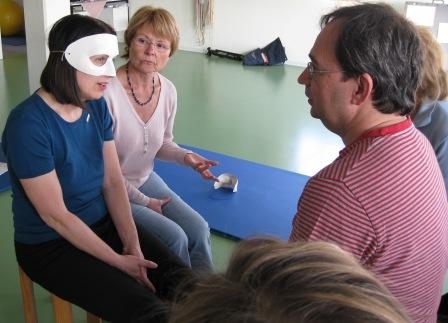
From the encounter of two (“mirrored doubling”) with the trainer’s support...
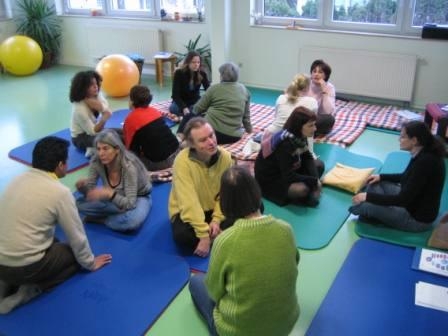
... to the whole group encounter of two (encounter in dyads)
Through the technique of sequencing, the necessary language is imparted ad hoc, following the participant's wish for expression. A varied and versatile use of the new language is enabled through the spiral build-up of the sequence and "retake" of the situation with changes to the parameters. Mastery is thus facilitated. These techniques also encourage a flexible approach to the foreign language from the very start.
Pronunciation
Coming into contact with a foreign language
means to come into contact first with a foreign rhythm.
The participants are sensitized to the importance of articulation when first introduced to the foreign language. Precise techniques familiarize the participants with the peculiarities of the rhythm, melody and articulation of the foreign language. Other exercises and methods, amongst others, doubling and mirroring, enable an accurate perception of the characteristics of the language.
Purposeful, selective and well targeted movements ease the perception and reproduction of specific oral characteristics of the language. Poems highlight the rhythmic, melodic and phonemic characteristics of the language. The verbo-tonal method plays a major role in the correction of pronunciation. (see Bibliography Dufeu, 1976, 1986, 1990, 2001, 2003: 267-316)
These techniques are also implemented in courses with advanced participants that have or haven't been corrected enough. The foreign language thus loses a part of its foreignness. The students familiarize themselves with the language and integrate it more easily.
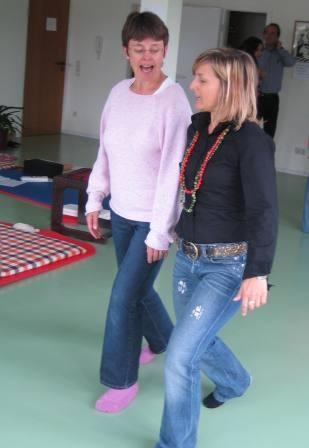
Walking out the rhythm of a sentence in the foreign language.
The lexis
As the participants familiarize themselves with the sound of the foreign language through the help of techniques such as doubling and mirroring in the initial stages of a PDL courses, they also acquire a “core vocabulary”. They can use this as a base to express themselves in later exercises. Language is acquired in situations that appeal directly to participants. The connection between speaker and what is spoken, the speaker and the wish for expression, and the situations and the use of the language, make it easier to acquire the language and motivate the participants.
The access to meaning
The access to the meaning of unknown utterances is facilitated by the strong connection between speakers and their statements, and between statement and context. There is in fact a reversal of the normal direction of communication. The participants are the initiators of the language and it is the trainer who has to understand what they want to say and offer them the language they need. The process of comprehension is also facilitated in PDL by the construction of the language sequence. The trainer begins with the participants' statements and gradually elaborates on and expands them.
Sense sometimes comes through the senses.
The denotative meaning of a statement is conveyed via the connotative signification of the utterance. The participant becomes aware that the meaning of a message not only lies in the “what” but also in the “how”. To achieve this, a sensitization to other modes of perception must be fostered in the acquisition process.
Remembering
The close relationship between the speakers and their statements makes it easier to remember new language. This is also furthered by the sequencing, charging and retaking phases in which the new language is repeated and expanded upon and parameters varied. (see above).
Discovering the structures of the foreign language
Grammar is not separated from language.
The discovery of linguistic patterns happens on the cognitive level partly subconsciously, and partly through conscious processes of analysis and deduction.
The reflection on grammar in the group is based on problems and questions the participants raise when certain corrections haven't been understood. It can also occur at the initiative of the trainer when she considers a grammatical explanation more economical and necessary for the group. This reflection on grammar is in an output position and not input; i.e. the grammar is not programmed and planned a priori, it arises out of the current use of the language. The conscious learning process is directly connected and intertwined with the acquisition process. Reflection rests directly on experience with the language.
This approach doesn't plan the solution of problems in advance, it follows the needs of the group. The basic principle of PDL is valid here too: Follow rather than lead.
The approach to grammar is here also participant– and group-oriented. We do not start off aiming for a complete knowledge of grammar, but deal with it as it arises in the group.
As much as possible, the participants discover grammar patterns themselves in similar language phenomena raised and used before by themselves. When necessary, the “Conceptualization Technique”, developed in the 1970s by H. Besse, is used (cf. u. a. H. Besse : „Les exercices de conceptualisation ou la réflexion grammaticale au niveau 2.“ In Voix et Images du Crédif 1974/2, 38-44).
This method makes it possible to proceed from the level of the participants and what they know, and to formulate a rule at first with their own words based on their knowledge of the foreign language and referring to what they had already encountered before discovering the rule.
The trainer has a structural and orientational function here. She subsequently offers the meta-language for the participants to understand the technical terms in other contexts such as classical grammar books. The conceptualisation technique is not usable for some complicated syntactical phenomena (e.g. the use of the subjunctive or the use of the past tense in French). In these cases she gives a straightforward explanation. These explanations are based on the concept of intentional grammar (see Bibliography: Dufeu, 1982, 1993a and 1993b).
Attitude to mistakes
Making mistakes does not only belong to the learning process, it promotes it. It enables the discovery of structures and limits of the foreign language. This does not mean that PDL has a laissez-faire attitude to mistakes. It assumes that the more correctly one is able to speak, the more precisely one can express oneself.
When a participant makes a mistake, correction is offered. Depending on the level of linguistic maturity, he may choose to accept the correction and integrate it, or he may need to receive the same correction a few times in order to recognize it and to integrate it into his usage.
La grammaire en Psychodramaturgie Linguistique
The Acceptance of Intercultural Differences
A pedagogy of difference
Many PDL exercises enhance the development of listening and observation skills that contribute to the understanding and acceptance of the other in its “otherness”. Psychodramaturgical processes also allow the participants to experience directly from within and thus better understand the cultural differences of the target language.
The particular access to texts that highlight specific aspects of the foreign culture also contribute to a deeper knowledge of the foreign culture.
The Introduction of Writing
Writing is introduced progressively. In the early stages of a course, priority is given to oral communication. The first transcriptions are brought in at the end of the second day in a beginners’ course. The participants are asked to transcribe statements that came up in class and caught their interest. Their notes are then corrected and they begin to discover rules and patterns of the writing code. These statements are then integrated into their original context as much as possible. During the first week of a beginners’ course, the activities are directly related to the language brought up spontaneously by the students themselves. Progressively, the connection between speaking and writing becomes intertwined, although the written exercises are used in relation to their function in communication situations.
Texts are used also as triggers and foster the participant’s wish for expression. They are mostly selected for their dramaturgical criteria, (see above) group dynamic qualities or for their thematic interest. They also serve to enlarge the writing code in the foreign language and to expand the participants’ knowledge of the foreign language and culture.
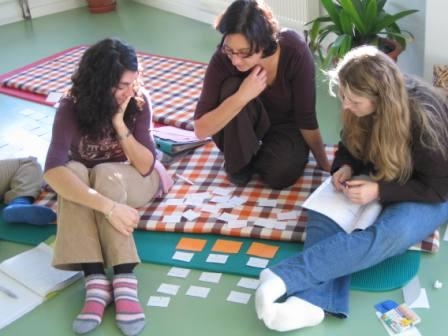
Advantages of PDL
As we have been working with PDL for more than 30 years, we think it is important to explain some of the advantages of PDL that influenced our choice of this method:
- The participants take possession of the language faster as it is experienced rather than studied and because it arises out of their needs, wishes, interests, thoughts and expectations. They participate directly in the linguistic development of the group and this in turn strengthens their relationship to the foreign language.
- The foreign language is personalized and brought to life, as it is a medium for expression and communication within the group (instead of just being the goal of a lesson). Its use therefore gains authenticity.
- The correspondence between the speaker and his statements raises the participants' interest in what is said and shared in the group. Mutual listening (we listen better when we don't know what is coming), retention (we remember what interests us), motivation (the desire to master the foreign language) grows. The second alienation (see above) is reduced or disappears.
- As it is the participants' language and expression, the new language is better retained and integrated.
- The activities stimulate a double interest; not only that of acquiring the foreign language but the personal interest which increases motivation.
- The participants' wish for expression is stimulated through the activities and contributes to the dynamics of the group.
- The attitudes, abilities, and skills necessary for learning a foreign language are developed through specific exercises. The acquisition and learning process is thus facilitated.
- Spontaneity and creativity are enhanced. Participants learn to use the foreign language flexibly and often develop a playful contact with it.
- The ability to express oneself is strengthened by the variety of the methods and techniques.
- The techniques of the verbal sequence, loading and retaking encourage a versatile approach to the language and fluency of speech.
- The sensitization of the participants to the prosodic and phonetic characteristics leads to the familiarization of the foreign language. Inhibitions are reduced and communication is made easier. The participants relate to the language and grasp it directly. The first alienation (s.a.) is reduced.
- A large number of PDL activities lead to a positive relationship to the language which reduces learning barriers. The participants can enjoy speaking the language and feel at home with, and in, the foreign language.
- The participants’ self-confidence and readiness to take risks in the foreign language increase as a result of the co-operative atmosphere of the group, the empathic relationship between participants encouraged by the trainers, the trainers’ attitude toward making mistakes, and as the result of the way in which individual acquisition rhythms are respected.
- The participants develop an attentive relationship to each other because they can engage with each other through the foreign language. In addition, the introduction of the imaginary allows participants to develop and play with the way they come into contact with each other.
- The use of the foreign language outside the class becomes easier because this language has been acquired by participants expressing themselves and communicating directly within the course: there is a correspondence between the function and the application of the foreign language inside and outside the class. There is what the neuroscientists call the “effect of the context”.
An approach to foreign language teaching in constant development
"Work in progress."
James Joyce
In accordance with the theoretical basis of Psychodramaturgy, new exercises, techniques and insights are in a continual process of development. The training of trainers is constantly improved and updated.
The scope of application of PDL is being widened thanks to the commitment of the trainers.
Originally developed for adults, it is now being used with adolescents and children. It was designed for groups and it is now being used frequently in one-to-one classes (monodramaturgy).
After a considerable period of development, the international resonance of PDL is increasing and spreading to more countries, e.g. Germany, France, Italy, Austria, Switzerland...
PDL trainers founded the International PDL Association in 2007 with the aims of raising awareness of the method and developing its application in an international context. The association organized the first PDL conference in 2008.
The developmental potential of PDL is immense. The method invites all those involved in the process of language acquisition to explore the other bank of the river of pedagogy.
Links
You can find more information about the fundamental pedagogical principles of PDL at
The fundamental hypotheses of PDL
For a better understanding of PDL in practice see:
If you want to find out more, have a look at the bibliography and see: Bernard Dufeu: Teaching Myself, OUP,1994 (currently out of print).
© Dufeu Bernard, 2001
Last changed: 18.03.2009
Translation: Robert Zammit.

